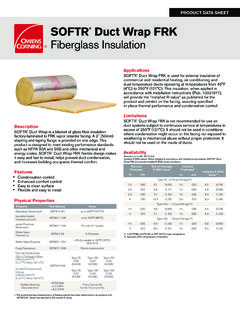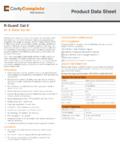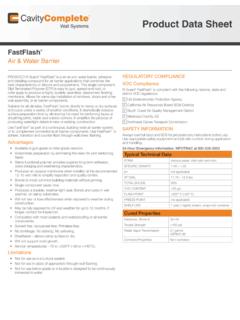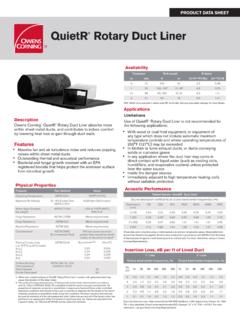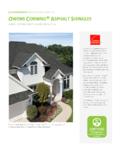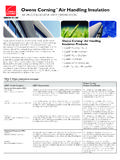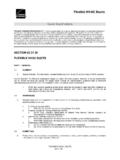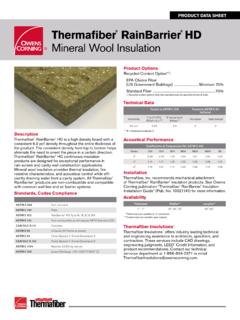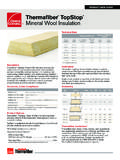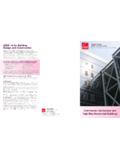Transcription of Underlayment Technical White Paper - Owens Corning
1 GlossaryDeckSurface installed over the framing on which shingles are installed, typically oriented strand board (OSB) or Slope Roof slopes that rise between two and four inches per FeltAsphalt roofi ng base material manufactured from cellulose fi Felt Asphalt-impregnated organic felt used as Underlayment ; also referred to as tar Paper or roofi ng square feet of roof area. UnderlaymentAsphalt-saturated organic, fi berglass or synthetic material used beneath roofi ng to provide additional protection for the Corning ROOFING AND ASPHALT, LLCONE Owens Corning PARKWAYTOLEDO, OHIO, USA 436591-800-GET-PINK No. 10012239. Printed in August 2010. 2010 Owens It Right Replacing a new roof is something most homeowners do only a few times in their lives.
2 Replacing a new roof is something most homeowners do only a few times in their lives. Do it right, and you will add decades of beauty, comfort and energy effi ciency to your home. Do it right, and you will add decades of beauty, comfort and energy effi ciency to your home. If done wrong, you may end up multiplying your initial investment in repeated repair costs. If done wrong, you may end up multiplying your initial investment in repeated repair costs. 1-800-GET-PINK KeyImportantApproved ProductExpert OpinionWarningcontinued on backUnderlayment What s Under Your Shingles?A common mistake in the installation of asphalt shingles is the practice of not using Underlayment . This is a big mistake for several reasons: Underlayment helps protect your wooden deck from moisture until the shingles are applied, and if the shingles are blown off at a later time After installation, wind-driven rain can get under shingles and damage the inside of your home.
3 Underlayment provides another layer of protection Underlayment is generally needed to maintain a Class A Fire Rating for your roof assembly Your insurance company may require shingles to be installed according to manufacturer s specifi cations, which usually call for Underlayment Underlayment protects shingles from resins that can be released by the wood decking Underlayment can help bridge irregularities in decking to make your roof look betterFor all of these reasons and more, Underlayment is a critical part of a complete roofi ng this bulletin will help you: Understand the importance of Underlayment in your roofi ng system Understand the variety of roofi ng underlayments available to youFrom Owens Corning Roofi ngAn EDUCATIONAL SERIES on the importance of installing a complete roofi ng systemIt takes more than shingles to create a high-performance roof.
4 It requires a system of materials and products working together. This report explains why Underlayment is critical for maximizing the performance and beauty of your roof. Underlayment 101 Your roof is a system designed to shed water. Rain and snowmelt travel down the slopes of your roof to the gutters that collect it or carry it away. Shingles rely on the slope of the roof and gravity to move the water and keep it from entering your this process works well most of the time, it is possible for wind-driven rain to get under your shingles or enter along valleys where water fl ows. Without Underlayment , you have nothing to prevent a leak from occurring. With Underlayment , your home has a second line of defense to keep water channeled down the slope and away from your known as roofi ng felt or tar Paper , Underlayment has for decades been made with an organic, Paper -based felt that is saturated with roofi ng asphalt.
5 The material is sometimes called 15- or 30-pound felt because a square of the product originally weighed 15 or 30 pounds. Asphalt-saturated felt is water resistant; therefore it provides a temporary barrier against the elements. On low slope roofs, building codes typically require that Underlayment be doubled to protect the roof sheathing and structure from moisture penetration. Additional leak protection can be added by applying a layer of self adhering waterproofi ng in roofi ng systems and underlayments have led to stronger, longer-lasting products that can hold up better against the worst that nature has to offer. These products should be considered for additional protection to your s possible for wind-driven rain to get under your shingles.
6 Underlayment provides a second line of defense to keep water away from your on backThe Asphalt Roofi ng Manufacturers Association recommends using laboratory-tested asphalt shingle Underlayment products complying with ASTM standards D4869, D226, or D6757, which may be required by the shingle manufacturer and/or the building Corning Fiberglas-Reinforced Felt Underlayment has been developed to resist water, wrinkling and buckling, and lie fl atter under shingles. The surface of this advanced Underlayment can provide a consistent surface, reducing slipping, sticking and scuffi ng and can be as much as 40 percent lighter than organic felt products, making it safer and easier for your contractor to load, carry and underlayments have recently been introduced in the roofi ng industry.
7 They are typically constructed with a polymer fabric to provide a temporary waterproof barrier before the shingles are installed. The advantage of these underlayments is that they can be left exposed for many months, when installed properly, before the shingles are installed, helping protect your roof deck from moisture damage. To learn more about the Underlayment available from Owens Corning Roofi ng, visit Key Question to Ask Your Contractor for a Quality Roofi ng Job: What Underlayment are you applying with my shingles and why?.. Eventually, the water finds cracks in the roof deck and flows into the attic, where it could seep through the ceiling and interior DAMICICLESINDOORHEAT LOSSS ource: University of Minnesota ExtensionALFRED
